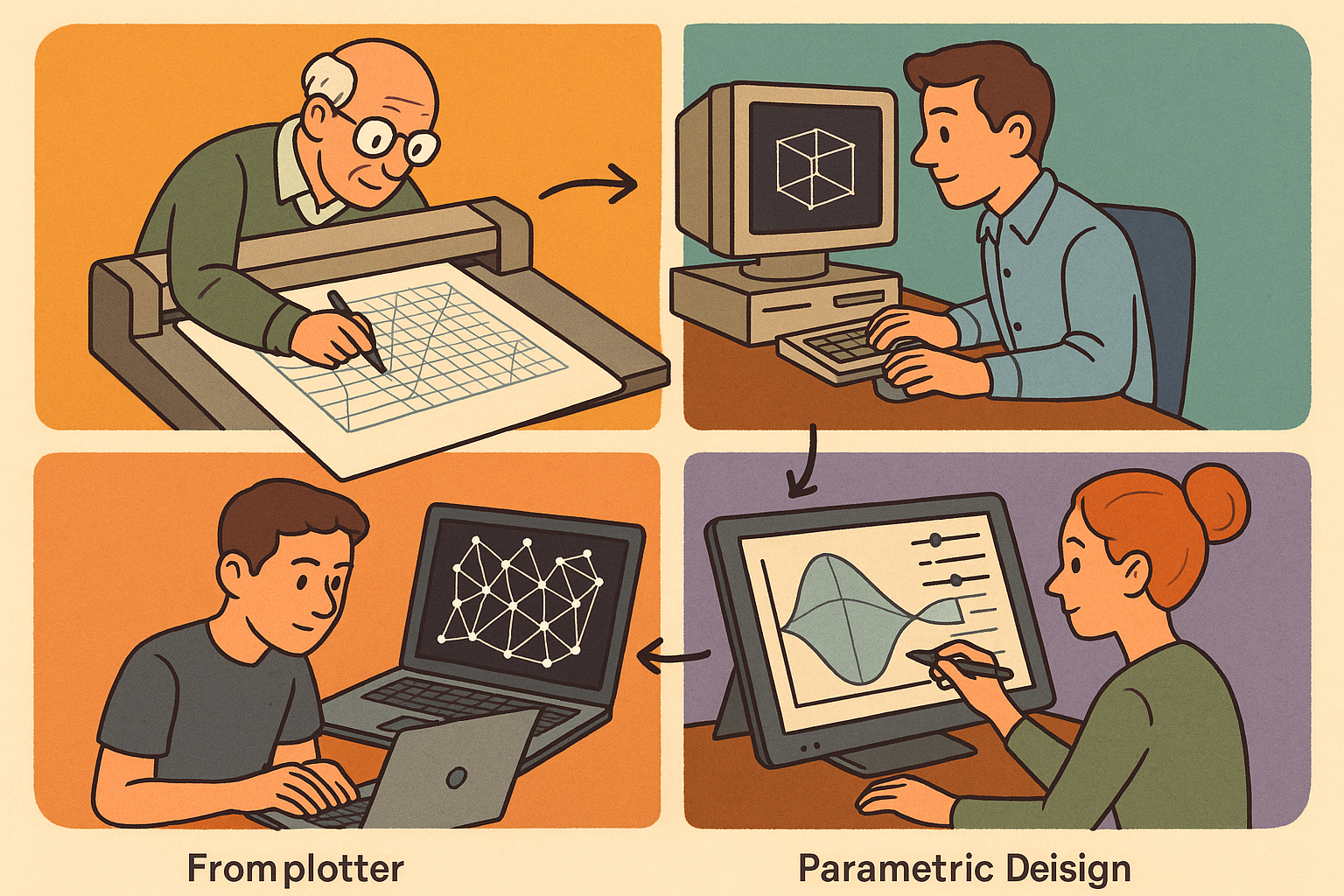Your Cart is Empty
Customer Testimonials
-
"Great customer service. The folks at Novedge were super helpful in navigating a somewhat complicated order including software upgrades and serial numbers in various stages of inactivity. They were friendly and helpful throughout the process.."
Ruben Ruckmark
"Quick & very helpful. We have been using Novedge for years and are very happy with their quick service when we need to make a purchase and excellent support resolving any issues."
Will Woodson
"Scott is the best. He reminds me about subscriptions dates, guides me in the correct direction for updates. He always responds promptly to me. He is literally the reason I continue to work with Novedge and will do so in the future."
Edward Mchugh
"Calvin Lok is “the man”. After my purchase of Sketchup 2021, he called me and provided step-by-step instructions to ease me through difficulties I was having with the setup of my new software."
Mike Borzage
Design Software History: Evolution and Impact of BIM Standards: Transforming Architecture and Construction Through Interoperability and Collaboration
November 03, 2024 6 min read


Introduction
Building Information Modeling (BIM) has revolutionized the architectural and construction industries by transforming traditional design and building processes into a collaborative and integrated digital environment. BIM is not merely about creating 3D models; it represents a comprehensive approach to project management that encompasses the entire lifecycle of a building—from conceptual design through construction and eventual demolition. It allows stakeholders to visualize, simulate, and analyze building performance, facilitating better decision-making and fostering innovation. The significance of BIM in contemporary practices cannot be overstated; it has become a fundamental component in achieving efficiency, reducing costs, and improving the quality of construction projects. As the complexity of building projects increases, the importance of evolving standards becomes critical to ensure interoperability, collaboration, and efficiency in the design process. Without common standards, the potential of BIM could be undermined by incompatible software systems and fragmented communication among project teams. The development and adoption of standards like the Industry Foundation Classes (IFC) and the BIM Collaboration Format (BCF) have been essential in addressing these challenges. IFC serves as an open, neutral data format that enables the seamless exchange of information among different software applications, ensuring that all stakeholders can access and utilize data effectively. Meanwhile, BCF provides a structured method for communication, allowing teams to exchange information about issues, changes, and updates within the BIM environment. Together, IFC and BCF are critical standards that underpin the successful implementation of BIM, facilitating a more collaborative, efficient, and integrated approach to architectural and construction practices.
Historical Context of BIM Standards
The emergence of Building Information Modeling (BIM) in the early 2000s marked a pivotal moment in the history of the architecture, engineering, and construction (AEC) industries. Prior to BIM, professionals relied heavily on fragmented processes and 2D drawings, which often led to misunderstandings, errors, and delays in projects. Traditional methods lacked the ability to provide a holistic view, making it challenging to predict outcomes accurately or to foresee potential issues. With the advent of BIM, the industry began shifting towards a more integrated and collaborative approach. BIM introduced the concept of creating digital representations of buildings that included not only geometry but also crucial data such as materials, systems, and performance characteristics. This transformation necessitated the development of standards that could support the exchange and interoperability of BIM data across different software platforms and among various stakeholders.
The Industry Foundation Classes (IFC), developed by buildingSMART (formerly the International Alliance for Interoperability), emerged as a significant breakthrough. Introduced as an open and neutral data format, IFC allowed for the sharing and exchange of BIM data regardless of the software used, thus breaking down the barriers that had previously hindered effective collaboration. IFC enabled different disciplines to work together seamlessly, ensuring that models created in one software application could be accurately interpreted and utilized in another. Concurrently, as the need for improved communication within BIM processes grew, the BIM Collaboration Format (BCF) was introduced. BCF provided a standardized method for capturing and sharing issues, comments, and requests for changes directly within the BIM workflow. It enabled project stakeholders to communicate more effectively by attaching notes and views to specific elements within the BIM model, thereby facilitating faster issue resolution and enhancing overall project coordination. The evolution of these standards has been instrumental in harnessing the full potential of BIM, allowing for more efficient workflows and better project outcomes.
Current Standards and Practices in BIM
In the contemporary construction landscape, the implementation of IFC in real-world projects has become increasingly widespread, reflecting the industry's commitment to open standards and interoperability. Design professionals leverage IFC to exchange complex building models between different software applications, enabling architects, engineers, and contractors to collaborate more effectively. However, this practice is not without its challenges. One of the primary issues faced by professionals is the inconsistency in how various software platforms interpret and implement the IFC schema. This can lead to data discrepancies, loss of information, or misrepresentation of model elements during the exchange process. To mitigate these challenges, ongoing efforts are being made to refine the IFC standard and to encourage software developers to ensure compliance and consistency in their applications.
The adoption of the BIM Collaboration Format (BCF) has significantly enhanced communication and collaboration across various teams and software platforms. BCF facilitates the exchange of issues, comments, and change requests in a structured manner, linked directly to elements within the BIM model. The benefits of BCF include:
- Improved issue tracking: Allows teams to document and monitor issues with precise model references.
- Enhanced collaboration: Facilitates communication among stakeholders regardless of the software platform used.
- Reduced rework: Early detection and resolution of issues minimize the need for changes later in the project.
The use of BCF has been particularly beneficial in complex projects involving multiple disciplines, where clear and timely communication is critical to project success. By integrating BCF into their workflows, teams can reduce misunderstandings, minimize rework, and improve overall project coordination. The combination of IFC and BCF represents the current best practice in BIM implementation, providing a robust framework for data exchange and collaboration that is essential in today's fast-paced and technologically advanced construction industry.
Future Trends in BIM Standards
As we look towards the future, several emerging technologies are poised to influence the advancement of BIM standards significantly. One such technology is blockchain, which offers the potential to enhance data security, trust, and transparency within BIM processes. By utilizing a decentralized ledger system, blockchain can ensure that all changes and transactions within the BIM model are recorded immutably, providing an audit trail that enhances accountability among project stakeholders. This level of data integrity is particularly valuable in complex projects with multiple contributors, where ensuring the authenticity of information is paramount. Additionally, artificial intelligence (AI) and machine learning are expected to play transformative roles in BIM methodologies. AI can assist in automating routine tasks, optimizing design solutions based on predefined parameters, and predicting potential issues before they arise. For instance, AI algorithms can analyze massive amounts of data to identify patterns and trends, providing insights that can lead to more efficient and sustainable building designs.
These technologies are likely to drive the development of new BIM standards that accommodate advanced data processing and analytics capabilities. The integration of these technologies can lead to:
- Enhanced data security through blockchain-enabled verification and tracking.
- Automated design optimization using AI-driven tools and algorithms.
- Predictive maintenance and lifecycle management informed by machine learning insights.
Moreover, there is a growing emphasis on standardization efforts that focus on sustainable design and lifecycle assessment methodologies. As the construction industry grapples with the challenges of climate change and environmental sustainability, BIM standards are evolving to integrate performance metrics related to energy efficiency, carbon footprint, and resource utilization. This shift reflects a broader industry commitment to sustainability and the recognition that BIM can play a critical role in achieving these goals. Finally, there is a push towards greater integration of open standards and increased collaboration within the industry. By embracing open standards, the AEC industries can break down barriers to interoperability, streamline workflows, and improve project outcomes. This collaborative approach is essential for addressing the complex challenges facing the industry and for driving innovation in BIM practices.
Conclusion
In conclusion, the evolution of Building Information Modeling (BIM) standards such as IFC and BCF has had a profound impact on the architecture, engineering, and construction (AEC) industries. These standards have been instrumental in facilitating interoperability, enhancing collaboration, and improving efficiencies throughout the design and construction process. As we move forward, the necessity for ongoing development and adoption of these standards remains critical to foster innovation and to meet the ever-changing demands of the industry. The integration of emerging technologies like blockchain and artificial intelligence promises to further enhance BIM processes, leading to more advanced and efficient workflows. Additionally, the emphasis on sustainability and lifecycle assessment in BIM standards reflects the industry's commitment to addressing environmental challenges. The active engagement of all stakeholders—architects, engineers, contractors, software developers, and clients—in advancing and refining these standards is crucial. By working collaboratively, the industry can ensure that BIM continues to evolve to support more complex projects, improve communication, and deliver better outcomes. Ultimately, the importance of BIM standards lies not only in their technical specifications but also in their ability to bring people and processes together, fostering a more integrated and effective approach to designing and constructing the built environment.
Also in Design News

Design Software History: From Plotters to Procedural Intent: A Technical History of Generative and Parametric Design Software
January 04, 2026 13 min read
Read More
Semantic Meshes: Enabling Analytics-Ready Geometry for Digital Twins
January 04, 2026 12 min read
Read MoreSubscribe
Sign up to get the latest on sales, new releases and more …



